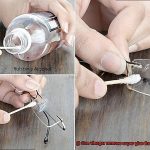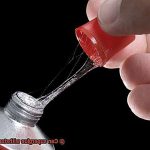Are you tired of your glue projects going up in smoke when things heat up? Ever wondered if super glue can handle the heat? Well, wonder no more. In this blog post, we’re diving deep into the world of super glue and its ability to stand strong against scorching temperatures.
Super glue, also known as cyanoacrylate adhesive (fancy name, huh?), has become a go-to for crafting, repairs, and everyday sticking needs. But when it comes to extreme heat, doubts start bubbling like a pot on the stove. Can super glue really hold its own under intense temperatures? The answer is simple: it depends.
Heat can do a number on super glue’s adhesive powers. Too much heat can cause it to crumble like a cookie in an oven, leading to weak bonds and potential project failures. However, fear not. Some types of super glue are specially formulated to withstand high temperatures, making them perfect for projects that require some serious heat resistance.
Knowing the limits of your trusty super glue can be a game-changer when tackling projects that involve scorching conditions. Whether you’re fixing a shattered ceramic mug or bonding metal components together like a boss, understanding how super glue performs under heat will help you make smart choices and achieve long-lasting results.
So, if you’re about to embark on a fiery project that involves some serious sizzle, stick around. In the rest of this blog post, we’ll explore how heat affects super glue’s performance, spill the beans on types that can handle high temps like champs, and dish out tips and tricks for maximizing this adhesive powerhouse in all your heat-related endeavors.
Get ready to unlock a whole new level of adhesive awesomeness.
What is Super Glue?
Contents
- 1 What is Super Glue?
- 2 Heat Resistance of Super Glue
- 3 How Does Super Glue Withstand Heat?
- 4 Temperature Range of Super Glue
- 5 High-Temperature Super Glue
- 6 Factors That Affect the Performance of Super Glue Under Heat
- 7 When to Use Super Glue for High-Heat Applications?
- 8 Alternatives to Super Glue for High-Heat Applications
- 9 Conclusion
Super glue, scientifically known as cyanoacrylate adhesive, is a remarkable adhesive that has gained popularity for its incredible strength and rapid-drying properties. From household repairs to industrial applications, super glue is the go-to solution for bonding a wide range of materials together. But what about its resistance to heat? In this blog post, we will delve into the temperature capabilities of super glue and discuss its performance in high heat conditions.
Understanding the Basics:
At the heart of super glue lies a liquid monomer called cyanoacrylate. When exposed to moisture in the air, it undergoes a rapid polymerization reaction that creates unyielding bonds between surfaces. This quick-setting property makes super glue an ideal choice for projects that demand instant adhesion.
Heat Resistance:
In general, most super glues have a heat resistance range of approximately 180°F to 220°F (82°C to 104°C). This means they can withstand moderate temperatures without compromising their bond strength. However, it is important to note that prolonged exposure to high heat can gradually weaken the adhesive properties over time.
Factors to Consider:
The specific brand and formulation of super glue can significantly impact its heat resistance capabilities. It is important to consult the manufacturer’s guidelines or check the product packaging for information on heat resistance before using it in high-temperature environments.
Application Limitations:
While super glue can handle brief exposure to high heat or intermittent temperature fluctuations, it may not be suitable for applications involving consistent extreme temperatures or direct exposure to flame. Certain plastics or rubber materials being bonded may soften or deform at high temperatures, compromising the overall bond strength.
Specialized High-Temperature Super Glues:
For projects requiring adhesives with enhanced heat resistance properties, specialized high-temperature super glues are available. These adhesives are formulated with additives that enable them to withstand temperatures exceeding 500°F (260°C), making them ideal for automotive repairs or industrial settings where extreme heat is a factor.
Heat Resistance of Super Glue
Super glue, also known as cyanoacrylate adhesive, has gained a reputation as a reliable adhesive for various materials due to its quick-drying and strong bonding properties. However, when it comes to heat resistance, super glue does have its limitations.
The heat resistance of super glue depends on the specific brand and formulation. Different manufacturers may have different temperature limits for their products. In general, most super glues start to degrade and lose their bonding strength when exposed to temperatures above 180°F (82°C). At higher temperatures, the glue can become brittle and break apart.
But the story doesn’t end there. The heat resistance of super glue can also be influenced by other factors such as the type of material being bonded and the duration of exposure to heat. Materials like metal or glass, which conduct heat more effectively, may make super glue bonds more susceptible to heat damage compared to bonds on materials like plastic or wood.
So, what should you do if you need an adhesive for high-heat applications? Look for specialized heat-resistant adhesives specifically designed for such purposes. These adhesives are formulated to withstand much higher temperatures and provide a stronger bond under extreme heat conditions.
However, if you’re determined to stick with super glue, there are certain types available on the market that are marketed as “high-temperature” or “heat-resistant” variants. These products are formulated with additives that enhance their ability to withstand higher temperatures without degrading or losing bonding strength.
But remember, even with these specialized variants, it’s essential to read and follow the manufacturer’s instructions regarding temperature limits and application guidelines to ensure optimal performance.
How Does Super Glue Withstand Heat?
Super glue, also known as cyanoacrylate adhesive, is a popular choice for bonding materials due to its fast-acting and strong adhesive properties. However, many people wonder if super glue can withstand high heat. In this article, we will explore the science behind super glue’s ability to withstand heat and provide insights into its limitations.
Chemical Composition and Bonding Process:
Super glue consists of cyanoacrylate monomers that polymerize or join together when exposed to moisture. This polymerization process forms a durable bond between surfaces. Moisture is crucial for effective polymerization.
Effects of Heat on Super Glue:
When subjected to heat, super glue initially experiences the evaporation of any moisture present on the surface. Without moisture, the glue cannot bond effectively. Additionally, the chemical bonds in super glue begin to break down at temperatures above 176°F (80°C), resulting in a weakening of its adhesive properties.
Variations in Heat Resistance:
The actual temperature at which super glue fails can vary depending on factors such as the specific formulation of the glue and the duration of heat exposure. Some types of super glue may be more resistant to heat than others. Specialized heat-resistant or high-temperature super glues are available in the market, designed specifically to withstand elevated temperatures.
Material Considerations:
The ability of super glue to withstand high heat also depends on the materials being bonded. Different materials have varying melting points, and if they reach their respective melting points before the super glue degrades, the bond may break due to material failure rather than the glue itself.
Temperature Range of Super Glue
Super glue, also known as cyanoacrylate adhesive, is an extraordinary adhesive that effortlessly bonds various materials. However, its performance and durability can be influenced by extreme temperatures. Understanding the temperature range of super glue is therefore essential for successful bonding in different environments.
Super glue is designed to withstand a wide range of temperatures, typically ranging from -50°C to 120°C (-58°F to 248°F). Different formulations may have slightly different temperature ranges, with specialized super glues capable of withstanding even higher temperatures.
In freezing temperatures, the bond strength of super glue may be compromised. The intense cold causes the glue to become less viscous, making it difficult to form a strong bond. Conversely, in scorching temperatures, the glue may soften or lose its adhesive properties altogether. This can result in weakened bonds or complete failure.
To ensure optimal performance in varying temperature conditions, it is advisable to select a formulation specifically designed for high-temperature resistance when using super glue in hot environments. These specialized glues are often labeled as “high-temperature” or “heat-resistant” and can endure temperatures above 120°C (248°F).
It is important to note that the temperature range of super glue can be influenced by factors such as the adhesive’s composition, the curing process, and the materials being bonded. Therefore, it is crucial to follow the manufacturer’s instructions regarding the temperature range and limitations of the specific super glue being used.
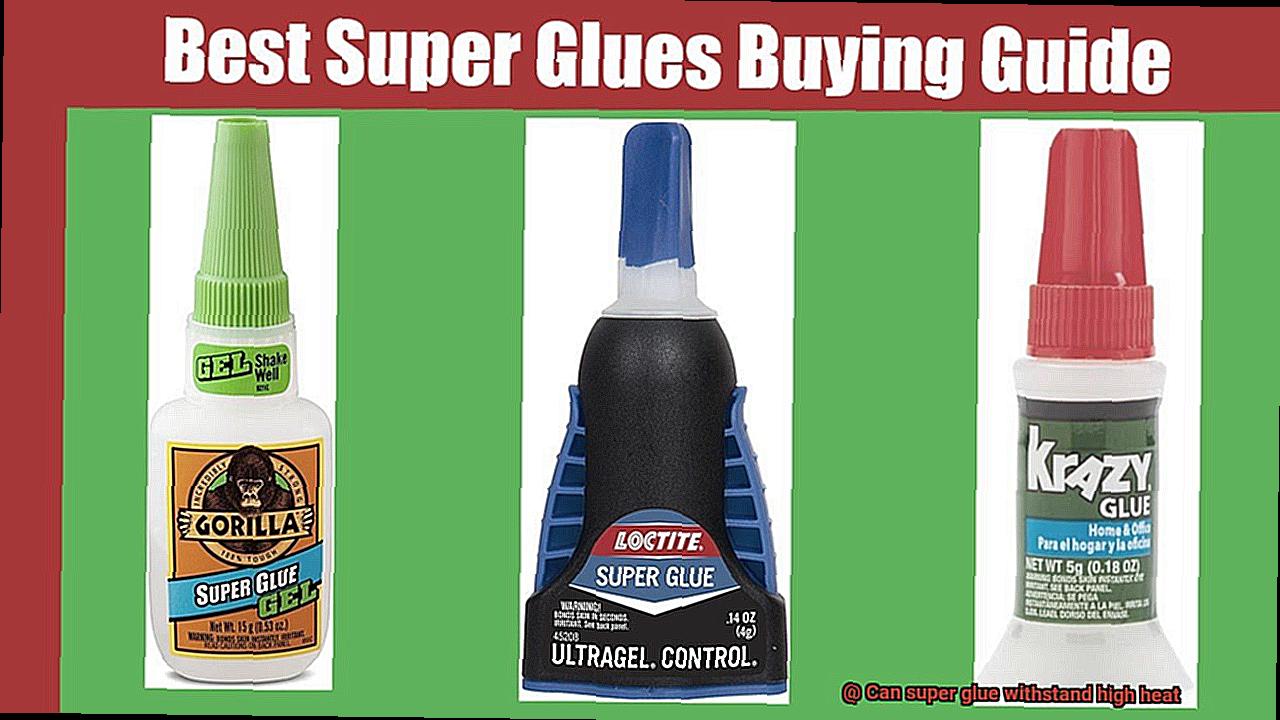
High-Temperature Super Glue
Unlike regular super glue, which loses its bonding strength when faced with intense heat, high-temperature super glue remains stable and reliable, like a superhero who never falters under pressure.
Here’s what you need to know about high-temperature super glue:
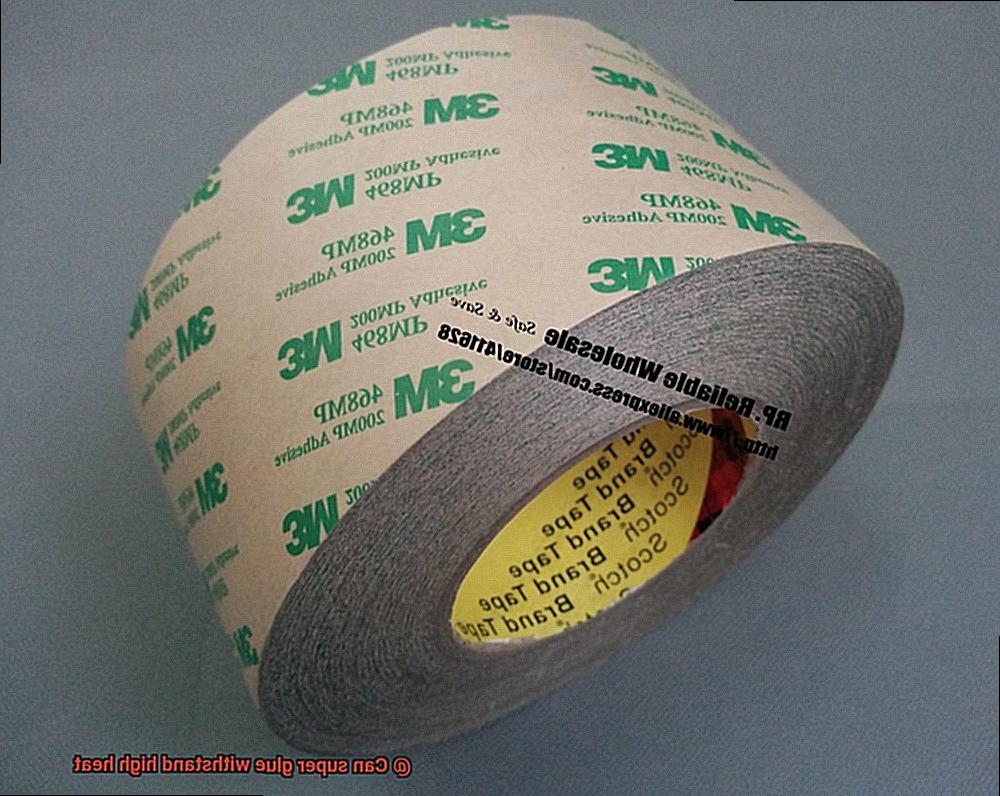
- Heat Resistance: High-temperature super glue can handle scorching temperatures up to 500 degrees Fahrenheit or higher. It’s like having an adhesive that laughs in the face of a blazing furnace.
- Unique Formulation: This adhesive boasts a secret recipe that gives it its incredible heat resistance. Special additives enhance its ability to maintain bonding strength even under extreme heat conditions, giving it a superpower-like advantage.
- Versatile Applications: High-temperature super glue finds its place in industries where heat resistance is crucial. Whether you’re bonding metal parts in engines, sealing electronic components, or affixing heat-resistant materials, this adhesive has got your back.
- Attention to Detail: While high-temperature super glue can handle extreme heat, it’s essential to consider factors like exposure duration and specific materials being bonded. Choosing the right adhesive for the job ensures optimal results.
- Safety First: When working with high-temperature super glue, follow the instructions carefully and ensure proper ventilation. The curing process may release fumes that require appropriate personal protective equipment.
- More Than Just Heat Resistance: High-temperature super glue offers additional fantastic qualities too. It has a fast curing time, excellent bond strength, and can resist chemicals and moisture. It’s like a Swiss Army knife of adhesives.
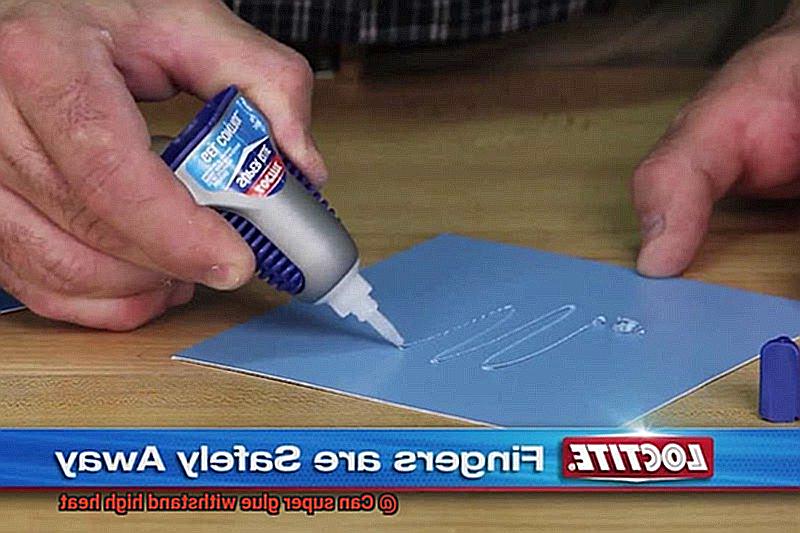
Factors That Affect the Performance of Super Glue Under Heat
Imagine a high-stakes project that requires a strong bond in the face of scorching heat. In these situations, super glue emerges as the hero of adhesives. But what factors dictate its performance under heat? To unravel this mystery, we delve into the chemical composition, temperature range, duration of exposure, surface material, and pre-bonding surface preparation that determine super glue’s heat resistance.
Chemical Composition:
Super glue’s secret lies in its chemical composition. Most super glues are based on cyanoacrylate, which is sensitive to heat. However, advanced versions have emerged, armed with additives and modifiers that enhance their ability to withstand high temperatures. These heat-resistant variations ensure that the adhesive properties remain intact even when the heat is cranked up.
Temperature Range:
Standard super glues start to falter above 150°F (65°C), losing their adhesive strength. However, fear not. There are super glues designed to withstand temperatures up to 400°F (204°C) or higher. To ensure resilience in the face of heat, check the manufacturer’s specifications or consult an expert.
Duration of Exposure:

Time can be a formidable adversary for super glue under heat. Even if formulated to withstand high temperatures, prolonged exposure weakens bond strength. Remember: the longer it’s exposed to heat, the more likely it is to lose its grip. Consider both maximum temperature and duration of exposure for optimal performance.
Surface Material:
Different materials have varying coefficients of thermal expansion. When exposed to heat, they expand and contract at different rates. This creates stress on the bond line, potentially weakening joints. Metals conduct heat well and may subject super glue bonds to greater stress. Selecting a compatible super glue is crucial for battling thermal challenges.
Pre-bonding Surface Preparation:
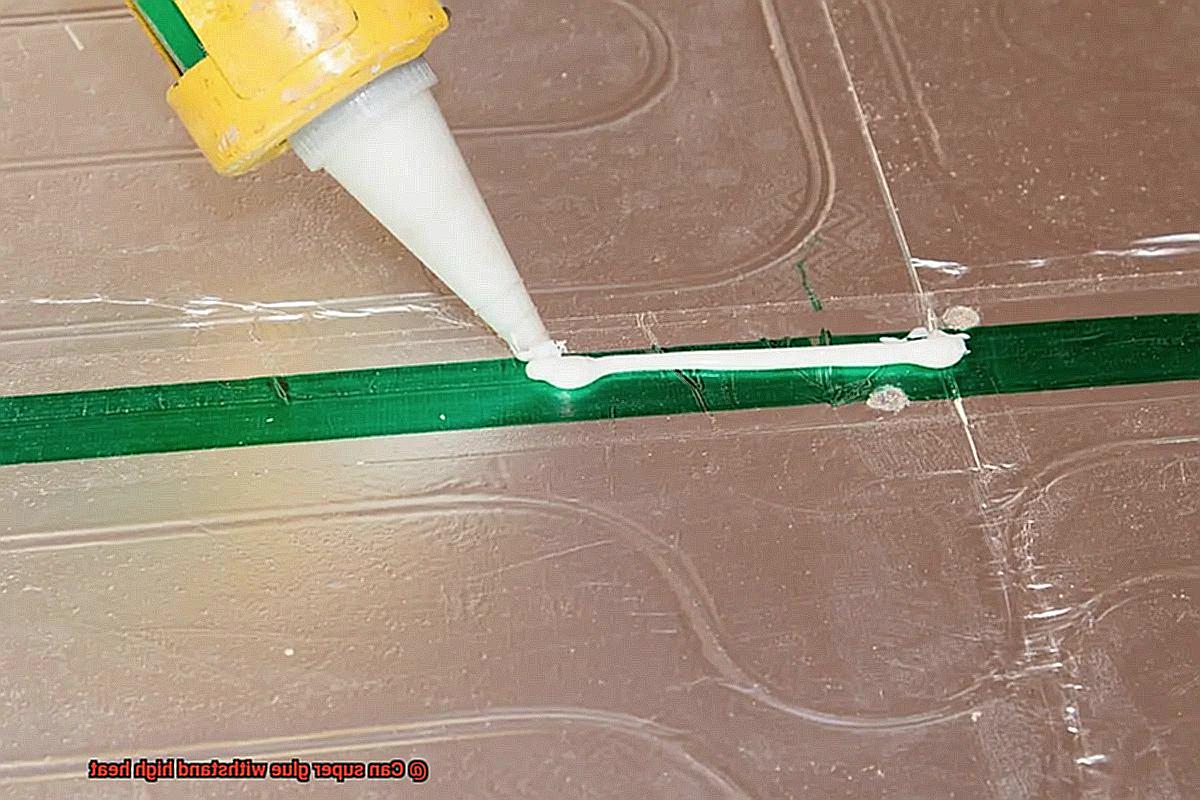
Proper surface preparation is essential for a strong bond, especially when heat resistance is crucial. Clean, dry surfaces free from contaminants guarantee optimal adhesion. Lightly roughening the surface can enhance bond strength, but excessive roughening creates more opportunities for heat to affect the bond line. Striking the right balance maximizes performance.
When to Use Super Glue for High-Heat Applications?
When it comes to high-heat applications, finding the perfect adhesive can be a daunting task. You need an adhesive that won’t buckle under the pressure of extreme temperatures, one that can maintain its strength and integrity. That’s where super glue comes into play.
Super glue, also known as cyanoacrylate adhesive, is a popular choice for bonding various materials due to its lightning-fast setting time and formidable bond. However, not all super glues are created equal when it comes to heat resistance. It is of utmost importance to choose the right type of super glue for your specific high-heat application.
Most standard super glues have a low heat resistance, typically only able to withstand temperatures up to around 180°F (82°C). Beyond this temperature threshold, the adhesive may begin to degrade or lose its strength, potentially leading to bond failure. Therefore, if you find yourself working with high-heat applications, it is crucial to seek out specialized super glue varieties that are designed specifically for these scorching conditions.
Heat-resistant super glues are formulated to endure higher temperatures, with some varieties capable of handling temperatures up to 500°F (260°C) or even higher. These heat-resistant super glues are often labeled as “high-temperature” or “heat-resistant” and provide a stronger and more reliable bond in extreme heat conditions.
However, even with heat-resistant super glue, there are limitations that must be considered. Factors such as duration of exposure, fluctuating temperatures, and thermal shock can all impact the bond’s ability to withstand high heat. In certain cases, additional measures may be necessary to safeguard the glued area from direct exposure to high temperatures. This can include utilizing heat-resistant coatings or sealants as an added layer of protection.
If you find yourself unsure about which super glue is best suited for your high-heat application, it is always wise to consult with adhesive experts or conduct tests beforehand. They can offer guidance on the most appropriate adhesive choice for your specific needs and help ensure a robust and enduring bond.
Alternatives to Super Glue for High-Heat Applications
I’m here to guide you through the world of alternatives to super glue for high-heat applications.
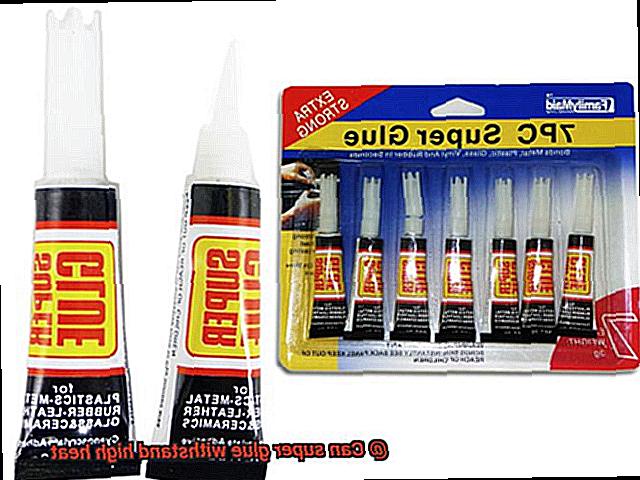
One popular alternative is epoxy adhesive, a versatile adhesive that offers exceptional bonding strength and excellent resistance to heat.
With temperatures up to 300 degrees Fahrenheit or higher, epoxy can handle the heat like a champion. It consists of two components – a resin and a hardener – that are mixed together before application.
Once cured, epoxy forms a strong and durable bond that will stay intact even in the hottest of situations.
If you need an adhesive that can handle even higher temperatures, silicone adhesive is your go-to. Silicone adhesives can withstand temperatures ranging from -65 degrees Fahrenheit to over 500 degrees Fahrenheit. Not only do they provide excellent resistance to heat, but they also offer good flexibility and electrical insulation properties. So whether you’re in the aerospace, automotive, or electronics industry, silicone adhesive has got your back.
But what if you’re dealing with extremely high temperatures? That’s where ceramic-based adhesives come into play. These powerful adhesives can withstand temperatures up to a scorching 2000 degrees Fahrenheit or higher.
They are often used in industries such as metallurgy, foundries, and power generation. When it comes to heavy machinery or metal bonding, ceramic-based adhesives are the ultimate choice.
When selecting an alternative adhesive for high-heat applications, there are factors to consider. The type of materials being bonded, surface preparation required, curing time, and application method all play a role in making the right choice.
It’s always a good idea to consult with adhesive manufacturers or experts in the field to ensure that you’re selecting the best adhesive for your specific high-heat application.
mLayFRQ7jdo” >
Also Read: How Much Weight Can Hot Glue Hold?
Conclusion
In conclusion, super glue has a certain level of tolerance for high heat, but its ability to withstand extreme temperatures depends on several factors. Standard super glues typically have a heat resistance range of about 180°F to 220°F (82°C to 104°C). However, continuous exposure to elevated temperatures can gradually weaken the adhesive properties over time.
Fortunately, there are specialized high-temperature super glues designed for projects that demand superior heat resistance. These exceptional adhesives contain special additives that enable them to endure temperatures exceeding 500°F (260°C), making them perfect for automotive repairs or industrial applications where intense heat is a concern.
When using super glue in high-heat situations, it’s crucial to consider the specific brand and formulation, as well as the materials you’re bonding. Some plastics or rubber materials may soften or distort under high temperatures, compromising the overall strength of the bond.
For applications requiring even greater heat resistance, alternative adhesives such as epoxy adhesive, silicone adhesive, and ceramic-based adhesives are excellent choices. These alternatives offer exceptional resilience against heat and can handle higher temperatures than standard super glue.
Ultimately, understanding the limitations of super glue and exploring alternative options will empower you to make informed decisions when tackling projects involving high heat.


